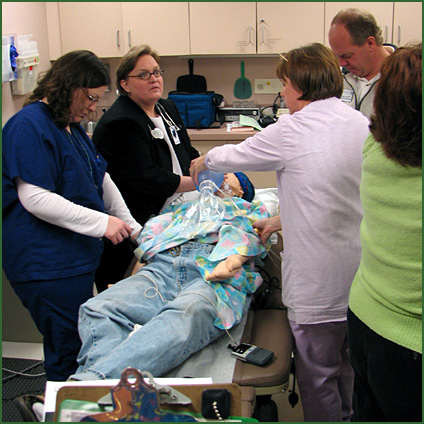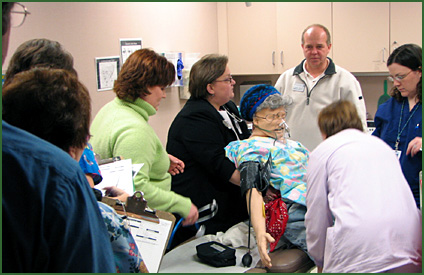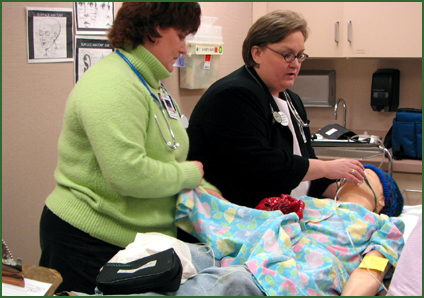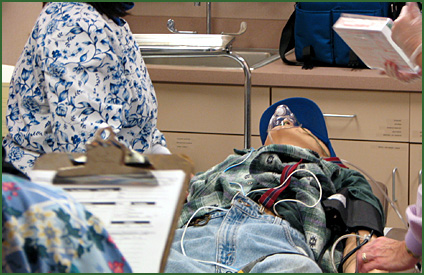The First 10 Minutes: Taking Medical Simulation to the Field
March / April 2007
The First 10 Minutes: Taking Medical Simulation to the Field
In recent years, with technology advancing alongside heightening patient safety concerns, the real and potential applications of medical simulation learning have become easier to appreciate. Simulation centers are now common at medical schools and teaching hospitals, allowing medical professionals to learn and evaluate skills without putting real patients at risk.

![]()
While simulation learning will never replace hands-on training with actual patients for many medical tasks, each year reveals new promise for the uses of simulation as clinicians worldwide experiment with emerging methods and refine existing approaches.
To date, most medical simulation training has been performed at simulation centers — purpose-built locations that provide an appropriate environment for many different kinds of simulation learning. Simulation centers have advantages in that they concentrate training facilities and staff in a central facility, making them versatile and convenient for managing a calendar of full-scale simulation training programs across different disciplines.
Simulation centers have an inherent limitation, however, in that they’re almost always removed from actual clinical locations and the real conditions they mimic. One can construct a very realistic ICU in a simulation center, for example, but the real clinical work will always be done in a real ICU somewhere else with conditions that may vary in small but meaningful ways.
This has prompted many to investigate the potential of taking certain kinds of simulation training from centers into the field — to the actual clinical locations in which people do their day-to-day work. The challenges of doing so are obvious: the changing demands of the clinical environment, the difficulty of removing staff from duties in their own workplace, the risk of interference or disturbance to patients, and so forth.
If these challenges can be managed, however, field-based simulations are possible and valuable in certain cases, as demonstrated by an experimental in-clinic simulation initiative called “The First 10 Minutes” program. This program was designed and conducted by the Minnesota-based HealthPartners, Inc., a family of nonprofit, consumer-governed healthcare organizations including a system of owned primary care and specialty care clinics.

![]()
Background
Since 2003, HealthPartners has operated its own simulation-based education center and program, the HealthPartners Simulation Center for Patient Safety (www.hpsimcenter.com), located at Metropolitan State University in St. Paul, Minn. It is a collaboration between HealthPartners’ Institute for Medical Education and the School of Nursing at Metropolitan State. In recent years, this facility has been used to train clinicians across a number of acute care practices such as emergency care, critical care, progressive care, critical care medical transport (ground and air), and nurse anesthetist programs.
In 2005, clinician leaders observed a potential application for field-based medical simulation training to assess and improve the management of emergency medical care in ambulatory settings — specifically the 21 primary/specialty care and 5 urgent care facilities within the HealthPartners system. The idea has its origin in a concern among many clinic staff medical staff that routine “skills days” focused on handling in-clinic emergency cases didn’t deliver the desired level of training effectiveness and readiness.
In-clinic acute emergencies are rare, but they do occur with some regularity — perhaps once or twice per month, depending on the clinic’s size. The frequency isn’t generally high enough for clinicians to feel seasoned or “drilled” by the actual instances themselves. The successful management of an emergency medical event in a clinic or urgent care setting requires that each member of the healthcare team know his or her specific roles and perform them efficiently and effectively. The best outcomes are achieved in an emergency when each team member is able to technically perform the required skills, communicate effectively, and work as a team.
Most emergent clinic patients in the Twin Cities area are transferred to hospital emergency departments. Recognizing this, the HealthPartners Simulation Center for Patient Safety and the clinician team developed a new curriculum based on simulation and adult-learning principles. The focus was narrowed to two priorities:
- effective management of the emergent clinic/urgent care patient during the time between identification of the emergency and the arrival of the ambulance crew (usually within 10 minutes of calling 911), and

- identification and management of two of the highest risk patients — those with chest pain and those experiencing allergic reactions.
The overall goal was to establish safe, effective, efficient, evidence-based care for emergent patients in those critical “first 10 minutes” in the clinic, while delivering exceptional hand-offs to EMTs or other emergency care providers.
While the clinics are within the same system, and standardized approaches were in place for dealing with these kinds of situations, planning teams discovered differences as the simulation program was assembled. For example, each clinic maintains a “code cart” — stocked with equipment that might be needed in the case of a serious medical problem, such as a defibrillator and medications. Ideally, these should be standardized such that if a clinician is working in more than one clinic, he or she will know where to find needed items instantly. Teams found, however, that there was considerable variation from clinic to clinic in terms of the carts’ contents and organization, increasing the risk of potential for errors in pressure situations.
While there were some specific items such as the above that the planning teams wanted to evaluate, the overall approach was largely exploratory and designed, through realistic simulation, to reveal learning opportunities and improvements not yet realized or captured.

![]()
A Typical Simulation
The key event in the First 10 Minutes in-clinic simulations is a “mock code” — a situation in which a patient would need to be resuscitated after having some sort of problem. It’s a case in which staff would need to respond accordingly and quickly prior to the arrival of emergency personnel. Common events, such as chest pain or allergic reactions following a flu shot, are selected for the exercises to enhance the realism of the simulations.
The simulation events themselves are not intended to take clinicians by surprise. They are preceded, in fact, by a special “skills day,” during which clinic staff rehearse the fundamentals of handling a “code.” Topics covered in this training include items such as how to turn on an oxygen tank and defibrillator, discussion of the various medications available on the code carts, and rehearsal of some basic procedures specific to each individual’s job functions.
About a week after the skills day, the actual simulation occurs. Simulation trainers return to the clinic with a “patient” (in this case a specially equipped mannequin) accompanied by a trainer playing the role of the patient’s family member. Clinic staff, aware of the general timing of the simulation, have advised patients who happen to be at the clinic that a training exercise is about to take place and that there is no cause for alarm.
The “patient” presents at the clinic’s front desk while the “family member” describes the patient’s symptoms in a realistic manner, such as “My father is having terrible chest pains. Can you help us?” The mannequin is accompanied by an actual paramedic who shadows the mannequin to provide his voice and to interpret events for the clinicians. The mannequin’s technical features allow it to provide basic vital signs and sounds that provide feedback on the “patient’s” condition and response to treatment.
From this point, the receptionist activates the clinic’s emergency procedures designed to care for the patient until an ambulance arrives. The “patient” is usually taken to an exam room while staff assemble to stabilize him, including physicians, nurses, assistants, and, where applicable, a pharmacist. Another staff member is assigned to the family member to handle his or her needs, while another is dispatched to call 911. The paramedic continues to play an interpretive role until the simulation ends and the “patient” departs.
Clinic procedures, of course, have been documented well in advance. Each clinic has a protocol to be followed in such cases. The simulations were designed, in part, to evaluate the staff’s knowledge of the procedures and ability to perform their own roles within them.
Each scenario is followed by a debriefing session attended by all participants, including the paramedic, who provides a recap of the event. This is an opportunity for clinicians to talk about the experience, review group and individual performance, and to capture suggestions for procedural changes. Where were there points of confusion or misunderstanding about roles? Were necessary supplies at the ready and easy to reach in a hurry? What might have made for a better outcome?
The program has shown that clinicians generally find the simulations to be quite realistic, and they also appreciate the opportunity to perform the simulation in their everyday workplace and with their usual colleagues. General evaluations of the simulations by participating clinicians have been overwhelmingly positive in terms of the effectiveness of the training and the relevance to their practice. Common suggestions have included more training on a regular basis (from quarterly to annually), similar training simulations with a pediatric “patient,” and variation of the types of “mock codes” simulated.
The debriefing process also entails a report back to the clinic management with suggestions for action steps to take. Certain clinic staffers are accountable for following up on the recommendations and seeing that changes are made.

![]()
Results
As the First 10 Minutes program is still rather experimental, planners have not yet sought to secure generalizable or reportable data for broader applications. They have, however, been able to determine a series of interesting qualitative conclusions suggesting the current value of the program to this clinic system and some potential directions for expanding the program.
At HealthPartners, the simulations have led to improvements in four areas regarding the management of in-clinic emergencies:
- Changes in the handling of pharmaceuticals. One of the most common results of the simulations was the finding of inconsistencies or possible confusing aspects of medicine arrangement on clinic code carts. For example, the simulations illustrated that certain medications housed in adjacent sections looked nearly identical, dosages in vials were unclear or difficult to see at a glance, or that expiration dates were hard to read.

- Changes in policies and protocols. The simulations have helped to reveal and address operational weaknesses or disconnects in clinic procedures for handling acute emergencies.

- Changes in equipment handling. Mock codes illustrated potential suggestions for improved storage and deployment of needed equipment, such as IV stands and bags.

- Clinician confidence and comfort with the process. A less tangible but equally important result has been the heightened sense of awareness and confidence gained by participants. A quote from one trainee demonstrates a welcome benefit realized some time after the simulation itself. “Today we had quite a serious medical emergency, and one of my medical assistants thanked me for the mock code experience,” the trainee wrote. “The patient today was having an anaphylactic reaction and the mock code drill was also anaphylaxis. The medical assistant said she knew what to do with the epi because of that drill.”
Conclusion
Experimental in-clinic initiatives such as the First 10 Minutes program illustrate some of the potential for moving medical simulation training from its traditional confines and out into the field for certain applications. This case illustrates that effective in-clinic simulations can deliver significant training benefits at minimal cost and relatively low levels of operational disruption within the clinic setting.
As concerns about patient safety continue to escalate, we may find field simulation an invaluable asset in making smart and meaningful improvements. Undoubtedly, simulation centers will continue to examine further opportunities to develop training curricula that can be used in the field, providing a useful adjunct to the good work that’s taking place within the centers now every day.
